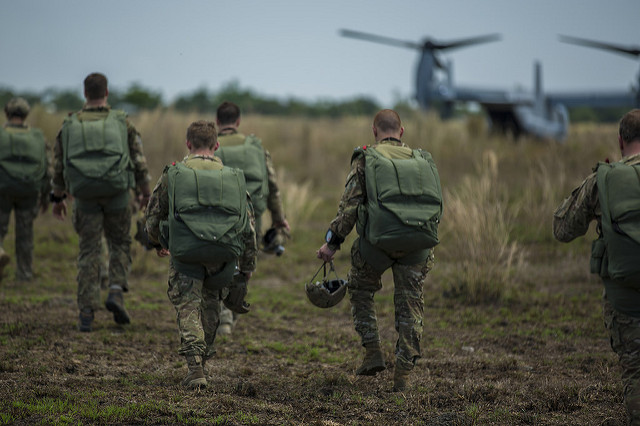On April 4, the annual Balikatan joint military exercise began in the Philippines, with China’s state media lambasting it as an example of how Manila is “involving outsiders in the territorial dispute in the South China Sea.” Balikatan, meaning shoulder-to-shoulder in Tagalog, started as an annual exercise between Philippine and U.S. armed forces focused on humanitarian assistance, disaster relief operations and conventional warfare. But in recent years, it has become a multilateral event thanks to the involvement of the Australian Defense Force. This year’s joint exercise involved an estimated 5,000 troops from the United States, 3,500 from the Philippines, and 80 from Australia, down from the 11,740 combined troops that took part in Balikatan 2015. This year officers and service personnel took part in a single training scenario that took the form of three different events on the Philippine islands of Luzon, Panay, and Palawan.
Balikatan 2016 was significant for three reasons: its greater emphasis on territorial defense; the presence of three Japanese Maritime Defense Force (JMSDF) ships as observers; and the visit of U.S. secretary of defense Ashton Carter. Coincidentally, this year’s military exercise took place as Manila and Washington prepare for the rotational deployment of U.S. forces at five Philippine military bases under the 2014 Enhanced Defense Cooperation Agreement (EDCA).
Historically, Balikatan exercises have been designed for various missions, including maritime security, territorial defense, humanitarian assistance, disaster mitigation, maritime law enforcement, and even environmental protection. This year’s military exercise heightened the territorial defense component, focused on improving the Armed Forces of the Philippine’s (AFP) capability for external defense and enhancing the two allies’ interoperability in maritime security and maintaining regional stability. The AFP tested newly acquired military materiel including FA-50 light combat aircraft, heavy landing craft (LCH), and M113 armored personnel carriers. The Philippine Air Force’s FA-50s trained with Hawker Hunters and A-10 Thunderbolts on air interception, interdiction, and ground support. The Philippine Navy’s LCHs joined a U.S. Navy dock landing ship in a maritime mobility exercise to enhance the two navies’ capability to respond to natural disasters.
The highlight of the Balikatan exercise was the deployment and test-firing of the U.S. Marine Corps’ M142 High Mobility Artillery Rocket System (HIMARS) in Crow Valley on April 14. This was the first time that this type of weapon system was used by the Marines in Balikatan and the first time it was deployed in the Pacific. With a maximum range of 186 miles (300 kilometers), the HIMARS is among the newest, most advanced mobile and land-based weapons in the Marine Corps’ arsenal. The U.S. military also deployed several air and land assets that supported Philippine and U.S. ground troops simulating retaking an oil-and-gas platform and launching an amphibious operation on a hypothetical South China Sea island.
This year’s exercise was also significant because of the presence of three JMSDF ships in the Philippines during the start of the military exercise. Two Japanese destroyers and a submarine arrived in Subic Bay on April 2 ahead of the start of the annual military exercise. Inside Subic Bay, the three Japanese ships joined seven U.S. Navy vessels that were docked in the port for Balikatan. The destroyers JS Ariake and JS Setogiri and the submarine JS Oyashio then participated in a series of confidence-building activities with the Philippine Navy. The three Japanese vessel did not take part in Balikatan but were invited to observe the exercise. This is an indication that Japan is interested in joining the annual military training exercise, and will probably participate in next year’s Balikatan. But the participation of the Japanese Self Defense Force in the 2017 exercise will only add to China’s trepidation that Balikatan is being used by the Philippines “to involve outsiders” in the South China Sea dispute.
Another first in this year’s Balikatan was the visit of Defense Secretary Ashton Carter to observe the exercise. Carter is the first U.S. defense secretary to observe Balikatan in its 32 year history. He observed the test firing of the HIMARS in Crow Valley and spent time onboard the USS John Stennis, alongside Philippine defense secretary Voltaire Gazmin, as the aircraft carrier transited the South China Sea. Carter also visited Antonio Bautista Air Base in Palawan, one of the five agreed locations where U.S. forces will be stationed on a rotational basis under EDCA. And in closing Balikatan, Carter announced that several U.S. military aircraft and helicopters would remain at Clark Air Base north of Manila. His presence during the exercise underscored the political significance of the Balikatan program for the two allies. U.S. Marine Lieutenant General John Toolan noted that Carter’s visit was intended to “reaffirm that the [security] relationship the U.S. have with the Philippines is rock solid.”
These three features of Balikatan 2016 reflect the changing nature of the Philippine-U.S. alliance in light of the heightened tensions generated by China’s expansion in the South China Sea. Although the alliance will still address non-traditional security challenges like natural disasters and terrorism, it is now being directed to maritime security and territorial defense. The participation of Australia, and possible inclusion of Japan next year, is an indication that other U.S. allies are being drawn into this geostrategic cauldron. It also highlighted that the Philippine-U.S. alliance will become more strategically relevant as the five agreed locations under EDCA enable the United States to revive its deterrent posture in the face of Chinese actions.
